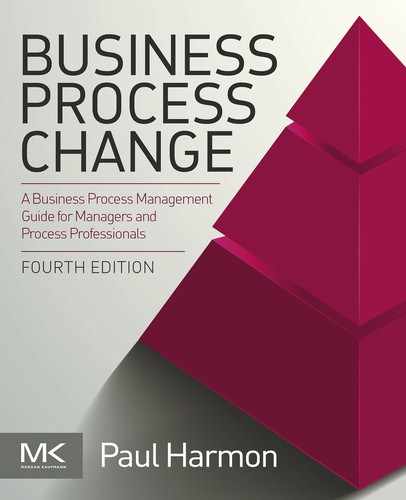Foreword to third edition by Thomas Davenport
Paul Harmon has a knack for writing clearly about topics that other people tend to obfuscate. Whether the topic is expert systems, e-business, or process management, he cuts through needless complexity and uses clear terminology to get the relevant points across. In this book, of course, he has focused on process management and associated technologies. There are unfortunately many possibilities for obfuscation in this topic area. Other people might confuse technologies with the actual business change involved in process management, but not Harmon. He is always careful, for example, to note that “BPM” means business process management and “BPMS” means systems that help accomplish BPM. If only other writers and speakers on these topics were so careful!
In this regard and in many other ways BPM is a model of clarity. All books on BPM should be this clear. In fact, all books about how to manage anything should be this clear. Process management should be treated—as it is in these pages—as one of the basic principles of contemporary management, rather than anything exotic or esoteric.
Why is an extremely clear approach to process management particularly important? One reason is that process management has been somewhat faddish in the past. As a management topic it has been a bit immature, coming in and out of fashion over time. For some reason managers and firms have often latched onto the more fashionable, short-term elements of the approach instead of the more timeless ones. There have been multiple flavors or different religions of the movement, including Total Quality Management, Reengineering, Six Sigma, Lean, and so forth.
Each decade seems to see the rise of a new flavor, although as Harmon describes many of the underlying principles are similar. Perhaps the excitement of a “new” approach (or at least a new combination of previous ideas with a new name) is necessary to get people excited, but there is a downside to this approach. The problem is that devotees of a new process religion become bored as rapidly as they were converted. Basic BPM may not be new or sexy, but it is clearly necessary. Perhaps it should be adopted whether it is sexy or not, and then perhaps it will persist over the long term without cycles or fads. This book goes a long way toward advancing that perspective on processes.
It is also apparent that process management, as it has changed over time, is a synthetic discipline. Each new process management approach has built on previous foundations, and added one or more new elements. This book, I am happy to note, also takes a synthetic, broad approach to process management. Ideally, an organization would be able to draw upon all of the elements or tools available to meet the process management needs of any individual project. Harmon provides a methodology for process management that contains most if not all the attributes an organization could need with regard to improving processes.
The book also takes—at least to my mind—the appropriate perspective on information technology (IT) in the process context. Most approaches to process management either devote too much attention to IT or too little. Some devotees of Reengineering and BPM technologies act as if IT is literally all that matters in improving processes. They usually achieve no business change as a result. Advocates of Six Sigma and Lean usually ignore technology altogether. However, IT is a powerful tool, and to ignore it is to leave a lot of potential change on the table. Harmon’s approach is like Goldilocks’ porridge: just right. It treats IT not as the primary objective of BPM, but as an enabler. Yet the book has plenty of detail and useful knowledge on how IT can help in managing and improving processes. Harmon has carefully updated the book since the 2002 edition to address the latest technologies in the realm of process management.
Finally, process management advocates—like enthusiasts for other management trends—often pretend that process management is the only business idea that matters. Get that right, the argument goes, and everything else about a business is either irrelevant or will automatically fall into place. Harmon is under no such illusions. He knows that processes must coexist with strategies, value disciplines, enterprise systems, and other aspects of organizational life. The book provides useful guidance on how process management relates to, and can support, other modern management ideas. As with other aspects of the book, it is a sober and realistic approach.
You have picked up the right book for just about any goal you have in process management. If you are an enterprise process architect or manager, Harmon tells you what you need to think about and do at the enterprise level. If you are an owner or improver of a particular business process, there is an entire section devoted to managing particular processes. If you are charged with using IT to support processes, you are similarly in luck. The book should be on the desk, in the briefcase, or on the bedside table of anyone who believes business processes are an important way to understand businesses and make them better.
